Funny to get a news feed indicating that “nowtopia” had popped up in an essay over on Counterpunch, written by a Torontoan… it’s a lovely essay, and flattering to see nowtopia becoming a useful noun already!
In May 2008 Nowtopia was published. It’s been a year and a quarter and I’ve had the great fortune to travel to many places and present the book, meeting incredible people, reconnecting with old friends, and it looks like I’m not finished yet! There is a good chance I’ll be making a trip to Buffalo this fall, and to Scandinavia for a mini-tour prior to the Copenhagen Climate Conference. The questions that I try to prepare myself for are the inevitable queries a couple of years from now: Was the analysis in Nowtopia wrong? Is this argument about a transition to a new way of knowing life really happening? What’s the evidence? And what about the notion that this is a process driven by a working class recomposing itself in terms of useful work?
I don’t actually think I’ll be able to answer those questions in two or three years. Part of my analysis gets me off the hook, because it doesn’t have to show up in a given amount of time to be “true.” On the other hand, if there is nothing happening that corresponds to my analysis, that might serve to debunk it, of course.
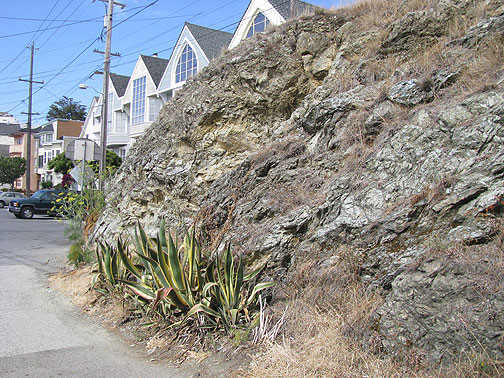
A bit of Potrero Hill on Kansas, hidden from through traffic.
One way I try to figure this out for myself is during my various walks around town, to see how the physical landscape is changing (it always is) and whether or not this matches up with some of my prognostications. If you’re a regular on this blog, you know I often put up photos of community gardens, and other visions of “nature in the city.” Yesterday I took a long walk with an old friend, up and over Potrero Hill (two peaks) to the edge of the I-280 freeway separating the “hill” from its former 3rd peak (Irish Hill) where Dogpatch and the abandoned shipyards are now. Then we went down into the UCSF campus at Mission Bay, which my friend, a guy who grew up here and lived in SF for 30 years, had never seen. That campus is one of the jarring and discouraging developments in the city these days, a sprawling campus of modern labs and offices, parking lots, and impersonal windswept lawns and wide sidewalks. Along the way we took some of my favorite hidden paths and stairways (one starts at 22nd and Kansas, another at 19th and Carolina), and lo and behold, we discovered a brand new community garden project in surplus Caltrans land at 18th and Connecticut at the freeway offramp. Here are some photos:
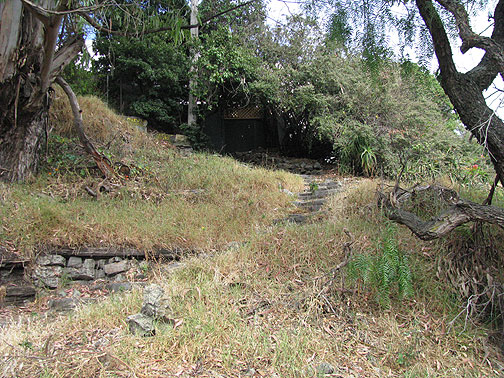
Near the 22nd Street overpass, where Kansas apparently dead-ends, a driveway goes up past flourishing trumpetvine bushes. Just 20 yards up the driveway this public path leaves to the east.
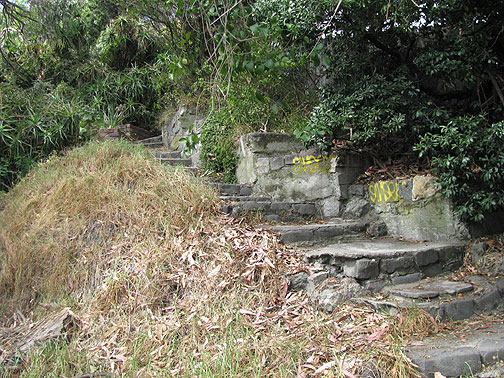
Kansas Street, for pedestrians only!
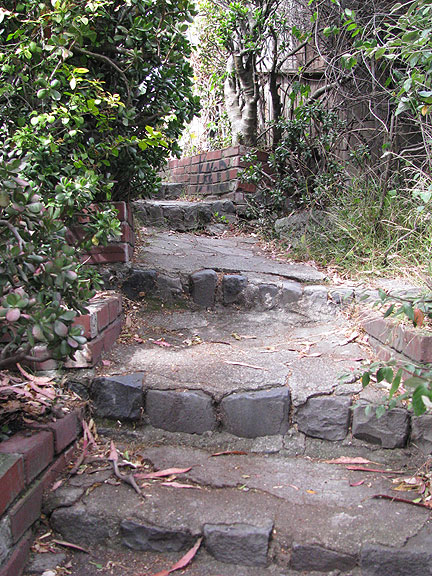
As you climb the stairs become more regular, and at the top you ascend a cement flight and emerge from behind a fence. This path is well hidden!
The big political discussion in the U.S. these days is about the health care proposals, with a lingering concern for the multi-billion giveaway to the banks. The health insurance companies are shaping the current debate, and it looks like they’ll have their way, perpetuating this wholly inadequate and insane for-profit sickness industry for some time to come. Walking through Mission Bay and its suddenly numerous buildings, several apparently dedicated to cancer research, and it’s difficult not to think that the real goal of all this public investment is to create the professional workers to fill the industry that profits from not curing cancer (or much of anything else) but the stabilizing of disease in such a way that the patients are permanently dependent on expensive drugs and machines and professionals. A great business, the frail but resilient human body!
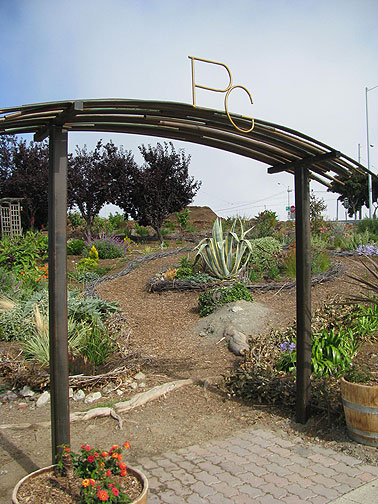
A brand new community garden has appeared at 18th and Connecticut on what I think is surplus Caltrans land.
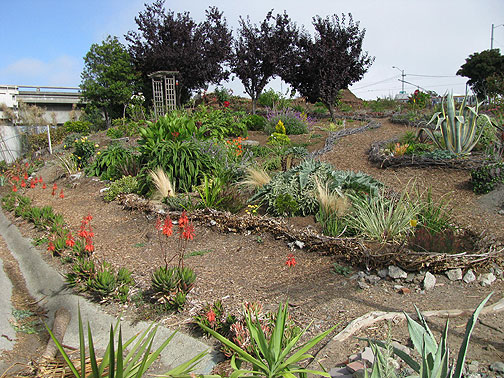
Another view of the new garden.
Not more than a 15 minute stroll from the heart of this heartless campus is “Channel Street,” the remnant of the real Mission Bay on which this campus has been precariously built (I marvel that San Franciscans are so trusting of modern engineering that there’s been nary a peep about building hazardous biotech laboratories on landfill, terrain notorious for liquefaction and collapse in major earthquakes). The creek is turning into an ecological treasure these days thanks to a lot of effort to replant native species along its banks. You can now see fish swimming in the erstwhile “Shit Creek,” which a few decades ago was an eye-watering pestilential sewer, along with dozens of birds species, all coexisting with the new condos and the splashing of baseballs at the mouth of the inlet. I got a few shots of the lovely community garden that has been maintained for many years by the houseboat dwellers along Mission Creek too:

Freeways swoop incongruously over Mission Creek community garden, the creek itself, and its dozens of houseboat residents.
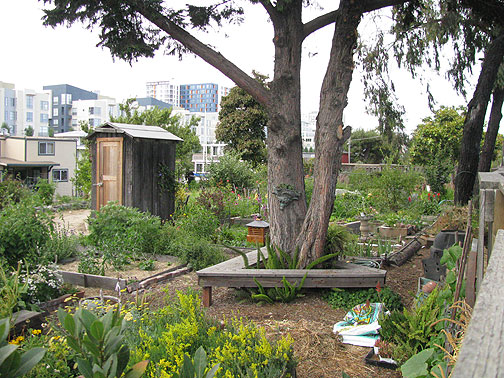
Considering this is all landfill, sitting next to a sewage outflow, in what were abandoned railyards, a tree this big seems downright majestic!
Much as I detest Gavin Newsom and his empty branding and endless co-opting of other people’s energy, superficially associating himself with as many new ideas as he can without ever doing anything to reallocate city resources in meaningful directions, he did recently publicly ask his department heads to analyze surplus lands for the possibility of converting said lands to urban agriculture. This would indicate something of the Nowtopian sensibility percolating outwards from the practical efforts of thousands of city horticulturists and small-time agriculturists, people actually creating the basis for imagining that growing a lot more food in San Francisco is not so far-fetched. Another surprising example of new thinking popping up in an unexpected place is the SF Chronicle’s sponsorship of a contest (with no mandate or money) to imagine other, temporary uses for the many approved buildings in the city, where vacant lots will now stand empty for years until credit and capitalist real estate investments start up again. I particularly loved the proposal from friends at REBAR, to create a People’s Public Works Department in the sprawling lots a block from CounterPULSE at 10th and Mission.
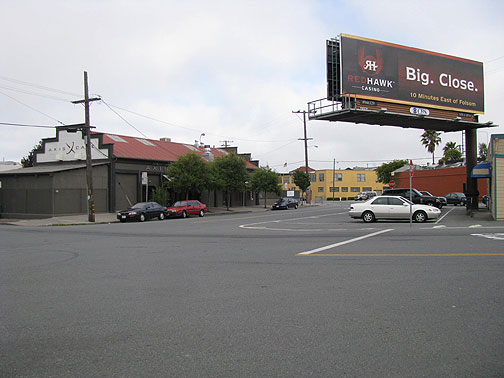
One of the areas identified for a new, temporary pocket park, finally starting to reclaim uses from the pointless expanses of asphalt. This is 8th, Wisconsin and 16th Streets in the former Mission Bay landfill, north of Potrero Hill.
Another example came from another old friend visiting from Davis the other day. Out there where it’s over 100 degrees all summer, his neighbors have mostly let their lawns dry out and go brown, but in their backyards, apparently it’s become quite the trendy norm to have chickens, vegetable gardens, and even beehives. With the recent publication of the hilarious and brilliant Novella Carpenter’s Farm City, a whole new “crop” of city dwellers are sure to be inspired towards urban animal husbandry. City codes and zoning rules will have to change in response to this grassroots surge.
Nowtopia is emerging in new daily life behaviors with genuinely radical implications; politicians try to co-opt such grassroots efforts, which at least indicates that something bigger is happening than a few hobbyists tinkering in the margins. But we cannot see any sign yet that people are starting to connect the work they do outside of wage-labor with a political agenda that might challenge the dominance of the money-based society. On September 26th, the local co-op networks are holding a “JAS Economy” conference (JAS = Just, Alternative, Sustainable, pronounced Jazz) which will showcase many efforts based on workers collectives and co-ops, as well as some of the growing efforts to embrace free and uncoerced work outside of monetary exchange. It’s a long way to shift our sensibilities from a world system that associates “worthwhile” and “value” with money and financial reward, but we’re probably a good deal closer to it today than we’ve been in a long time. Who knows how fast this new way of framing our daily activities can supplant the crumbling old order? Maybe faster than we think!












Great post Chris. The hidden gardens of SF need a tour guide. And thanks for the mention of our JASeconomy Festival. We think that this is the first of its kind anywhere and since you have readers all over creation we would be delighted to hear that we are wrong about that.
I would suggest that your readers go to the JASecon site (www.jasecon.org) and click on the News@Analysis link. We try to update significant developments of a nowtopian sort there. We got a super response to the article by John Curl on the 1930’s precursors of the Nowtopians, the members of the Unemployed Exchange Association (UXA). Curl’s completely revised and expanded history of the cooperative movement, For All the People, will soon be released by PM Press.